Test Case : Comsol - Cylinder
1. Introduction
This is the test case of High-Temperature Superconductors using the H Formulation on a Bulk Cylinder geometry surrounded by air in axisymmetric coordinates.
2. Run the Calculation
To run this case, compute the Study 1 solver on Comsol Multyphysics on the file CylindreBulkFormH_bis.mph.
3. Data Files
The case data file is available on Github here.
4. Equation
The H Formulation in axysimmetric coordinates is :
With :
-
\(H\) : magnetic field
-
\(\rho\) : electric resistivity \(\Omega \cdot m\) described by the e-j power law : \(\rho=\frac{E_c}{J_c}\left(\frac{\mid\mid J \mid\mid}{J_c}\right)^{(n)}=\frac{E_c}{J_c}\left(\frac{\mid\mid \nabla\times \textbf{H} \mid\mid}{J_c}\right)^{(n)}\)
-
\(\mu\) : electric permeability \(kg/A^2/S^2\)
5. Geometry
The geometry is a set of stacked tapes in axisymmetric coordinates \((r,z)\), surrounded by air. The geometry is created on Comsol, but in order to show the different physical names, this is a recreation on gmsh :

Geometry in Axisymmetrical cut
|
The geometrical domains are :
-
Cylinder: the cylinder, composed by a conductor -
Air&Spherical Shell: the air surroundingConductor-
Symmetry Line:Air's bound, correspond to \(Oz\) axis (\(\{(z,r), \, z=0 \}\)) -
Exterior Boundary: the rest of theAir's bound
-
Symbol |
Description |
value |
unit |
\(R\) |
radius of cylinder |
\(0.00125\) |
m |
\(H_{cylinder}\) |
height of cylinder |
\(0.001\) |
m |
\(R_{inf}\) |
radius of infty border |
\(0.1\) |
m |
6. Parameters
-
On
Cylinder:
Symbol |
Description |
Value |
Unit |
\(\mu=\mu_0\) |
magnetic permeability of vacuum |
\(4\pi.10^{-7}\) |
\(kg \, m / A^2 / S^2\) |
\(t_f\) |
final time |
\(15\) |
\(s\) |
\(b_{max}\) |
maximum applied field |
\(1\) |
\(T\) |
\(rate\) |
rate of the applied field raise |
\(\frac{3}{tf}b_{max}\) |
\(T/s\) |
\(hsVal\) |
time ramp for the applied field |
\(\begin{cases}rate*t &\quad\text{if }t<\frac{t_f}{3}\\b_{max} &\quad\text{if }t<\frac{2t_f}{3}\\b_{max} - (t-\frac{2t_f}{3})*rate &\quad\text{if }t>\frac{2t_f}{3}\end{cases}\) |
\(T\) |
\(J_c\) |
critical current density |
\(3.10^8\) |
\(A/m^2\) |
\(E_c\) |
threshold electric field |
\(10^{-4}\) |
\(V/m\) |
\(n\) |
material dependent exponant |
\(20\) |
|
\(\rho\) |
electrical resistivity (described by the \(e-j\) power law) |
\(\frac{E_c}{J_c}\left(\frac{\mid\mid J \mid\mid}{J_c}\right)^{(n)}\) |
\(\Omega\cdot m\) |
-
On
Air:
Symbol |
Description |
Value |
Unit |
\(\mu=\mu_0\) |
magnetic permeability of vacuum |
\(4\pi.10^{-7}\) |
\(kg \, m / A^2 / S^2\) |
\(\rho_{air}\) |
electrical resistivity of the air |
\(100\) |
\(\Omega\cdot m\) |
On MPH file, the parameters are written in the parameters category, the materials and as ad piecewise function for the applied magnetic field :
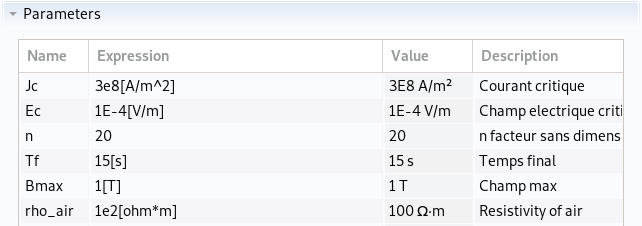
parameters
|
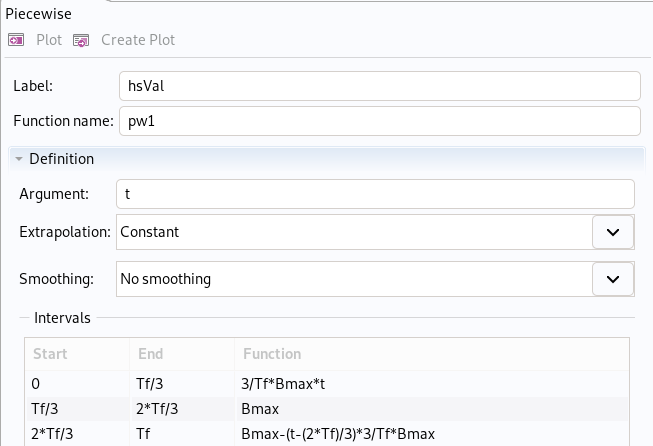
parameters
|

parameters
|
7. Boundary Conditions
For the Dirichlet boundary conditions, we want to impose the applied magnetic field :
-
On
Exterior Boundary: \(H_z = hsVal(t)/\mu\)
On MPH file, the boundary conditions are written :
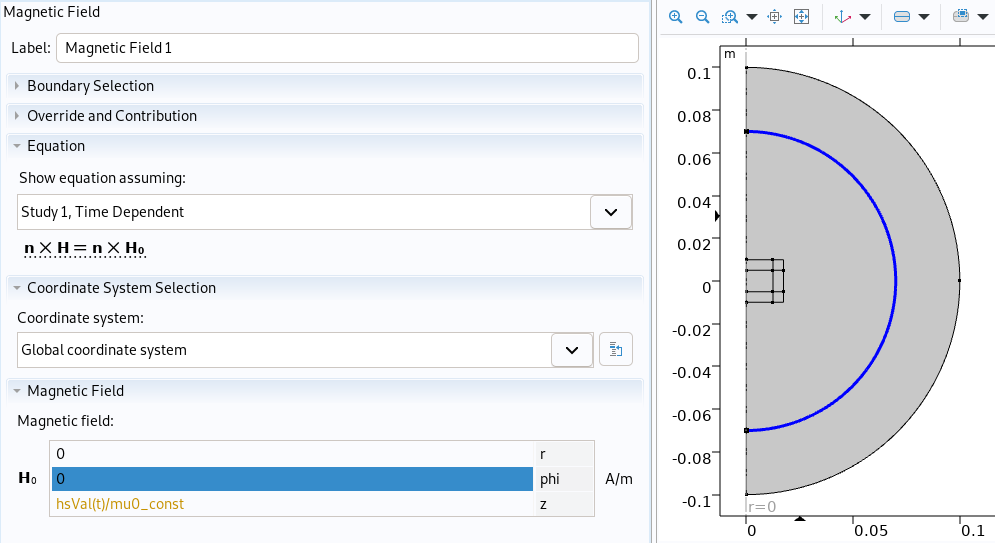
Dirichlet
|
8. Weak Formulation
9. Faraday’s law
For the H Formulation, the physic Magnetic Field Formulation (mfh) is used on Comsol. It allows to use the Faraday’s Law, which defined the H formulation :
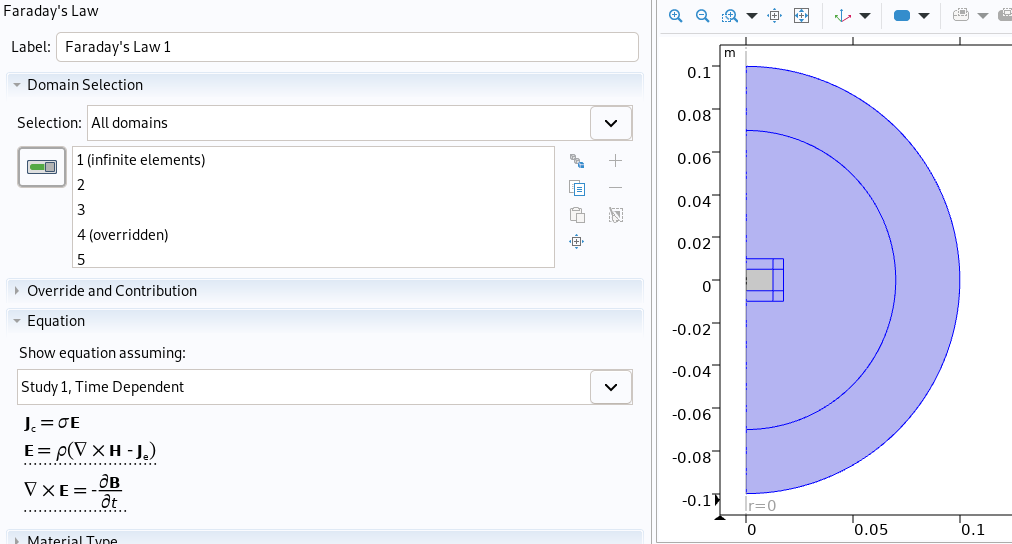
Ampère’s Law
|
10. Numeric Parameters
-
Time
-
Initial Time : \(0s\)
-
Final Time : \(15s\)
-
Time Step : \(0.1s\)
-
-
Mesh
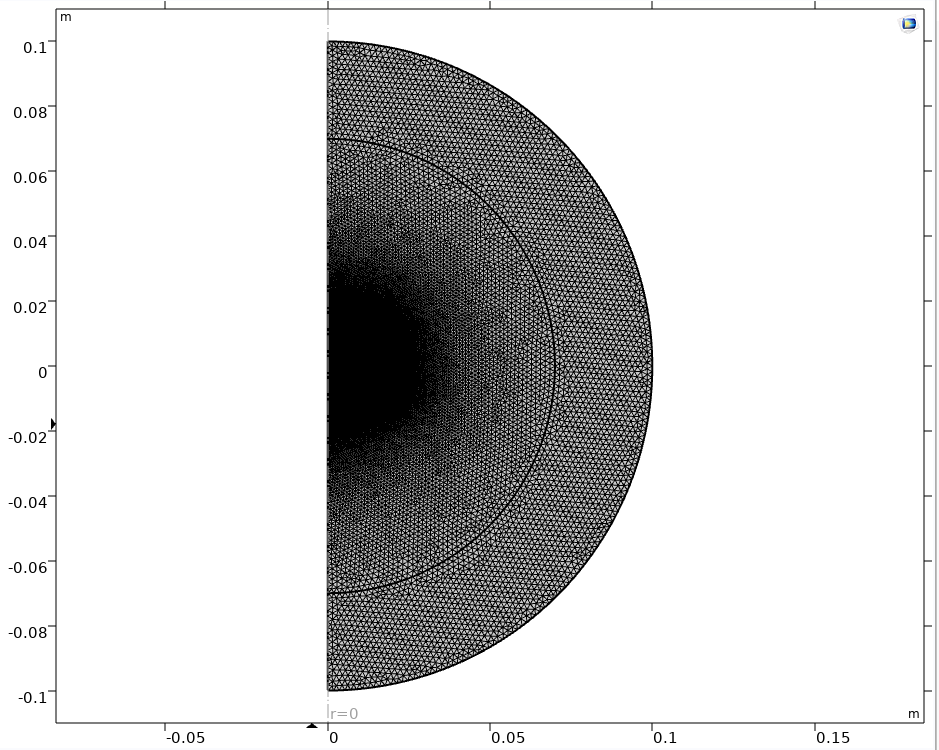
Mesh
|
11. Results
The results that we obtain with this formulation with Feelpp are compared to the results of the article Finite-Element Formulations for Systems With high-temperature Superconductors where the solver getDP is used.
The time evolution of the applied field is :
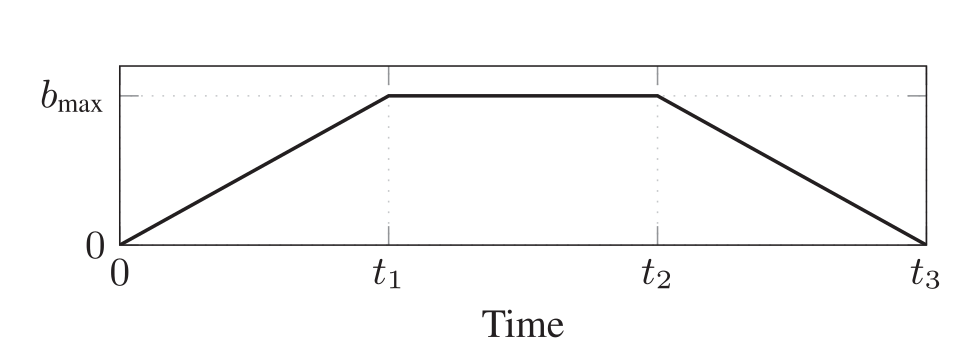
Time evolution of the external applied field
|
With \(t_1=5s\), \(t_2=10s\) and \(t_3=15s\)
11.1. Electric current density
The electric current density \(J\) is defined by :
We compare the current density profiles with Comsol and getDP on the \(O_r\) axis, at the mid-height of the cylinder, at time \(t_3\) for a maximum applied field of 1 T and \(n=20\), for a mesh of 30199 nodes.
L2 Relative Error Norm : \(10.72 \%\) |
11.2. Magnetic flux density
The magnetic flux density \(B\) is defined by:
r_component of the magnetic flux density \(B_r (T)\)
|
z_component of the magnetic flux density \(B_z (T)\)
|
We compare the distribution of the z-component of the magnetic flux density 2mm above the cylinder at the instants \(t_1\), \(t_2\) and \(t_3\) with Comsol and getDP.
t1 \(=5s\) |
L2 Relative Error Norm : \(1.15 \%\) |
t2 \(=10s\) |
L2 Relative Error Norm : \(5.59 \%\) |
t3 \(=15s\) |
L2 Relative Error Norm : \(2.99 \%\) |
12. References
-
Finite-Element Formulation for Systems with High-Temperature Superconductors, Julien Dular, Christophe Gauzaine, Benoît Vanderheyden, IEEE Transactions on Applied Superconductivity VOL. 30 NO. 3, April 2020, PDF